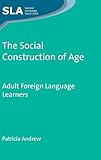TheSocial Construction of Age : Adult Foreign Language Learners / Patricia Andrew.
Material type: TextSeries: Second Language AcquisitionPublisher: Bristol ; Blue Ridge Summit : Multilingual Matters, [2012]Copyright date: ©2012Description: 1 online resource (200 p.)Content type:
TextSeries: Second Language AcquisitionPublisher: Bristol ; Blue Ridge Summit : Multilingual Matters, [2012]Copyright date: ©2012Description: 1 online resource (200 p.)Content type: - 9781847696144
- 9781847696151
- Language and culture
- Language and languages -- Age differences
- Language and languages -- Age differences
- Second language acquisition
- Sociolinguistics
- LANGUAGE ARTS & DISCIPLINES / Linguistics / Sociolinguistics
- EFL
- L2 learners
- SLA
- Second Language Acquisition
- age and foreign language learning
- age and second language
- age factor
- impact of age on language learning
- older language learners
- 401/.93 23
- P118.2 .A55 2012
- P118.2 .A55 2012
- online - DeGruyter
| Item type | Current library | Call number | URL | Status | Notes | Barcode | |
|---|---|---|---|---|---|---|---|
 eBook
eBook
|
Biblioteca "Angelicum" Pont. Univ. S.Tommaso d'Aquino Nuvola online | online - DeGruyter (Browse shelf(Opens below)) | Online access | Not for loan (Accesso limitato) | Accesso per gli utenti autorizzati / Access for authorized users | (dgr)9781847696151 |
Frontmatter -- Contents -- Acknowledgments -- Introduction: A First Glimpse of Age -- Part 1: Framing Age as Socially Constructed -- 1. The Age Factor and Second Language Acquisition -- 2. Present-Day Approaches to the Study of Age -- 3. Viewing Age through a Social Constructionist Lens -- Part 2: The Social Construction of Age in Mexico -- 4. Constructing Age in Later Adulthood -- 5. Constructing Age in ‘Middle’ Adulthood -- 6. Constructing Age in Young Adulthood -- Final Reflections -- References -- Index
restricted access online access with authorization star
http://purl.org/coar/access_right/c_16ec
This book explores the social construction of age in the context of EFL in Mexico. It is the first book to address the age factor in SLA from a social perspective. Based on research carried out at a public university in Mexico, it investigates how adults of different ages experience learning a new language and how they enact their age identities as language learners. By approaching the topic from a social constructionist perspective and in light of recent work in sociolinguistics and cultural studies, it broadens the current second language acquisition focus on age as a fixed biological or chronological variable to encompass its social dimensions. What emerges is a more complex and nuanced understanding of age as it intersects with language learning in a way that links it fundamentally to other social phenomena, such as gender, ethnicity and social class.
Mode of access: Internet via World Wide Web.
In English.
Description based on online resource; title from PDF title page (publisher's Web site, viewed 01. Dez 2022)


